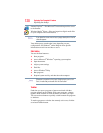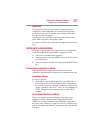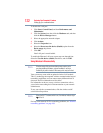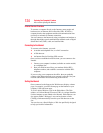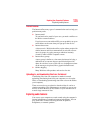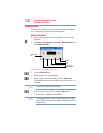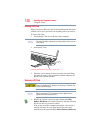
121
Exploring Your Computer’s Features
Setting up for communications
System tray
The System tray displays icons of tasks or programs that run
continuously in the background. To learn more about each task,
position the cursor over the icon for a few moments and a short
description of the task appears.
Typical tasks in the System tray are Current time, Power usage
mode, Mouse properties, and speaker volume.
To activate a specific task, double-click the appropriate System tray
icon.
Setting up for communications
To connect to the Internet, use an online service, or communicate
across the telephone lines with another computer, you need:
❖ A browser or communications program
❖ An Internet Service Provider (ISP) or online service if you plan
to use the Internet
❖ A way to connect to the ISP (for example modem/Wi-Fi
®
/LAN
etc.)
Connecting your computer to a network
You can connect your computer to a network to increase its
capabilities and functionality using one of its communication ports.
Accessing a network
To access a network:
❖ At the office, connect an Ethernet cable to the RJ45 jack on
your computer. For specific information about connecting to
the network, consult your network administrator. Many hotels,
airports, and offices offer Wi-Fi
®
access. If your computer has
Wi-Fi
®
, ask them for help when connecting to their Wi-Fi
®
network.
How to disable the Ethernet LAN port
When your computer starts, the Windows
®
operating system
attempts to contact a Dynamic Host Configuration Protocol
(DHCP) server. If the computer is not connected to a network, it
may pause a few minutes as it waits for a reply. To avoid this delay,
you can reconfigure the Windows
®
operating system to disable the
LAN port.










